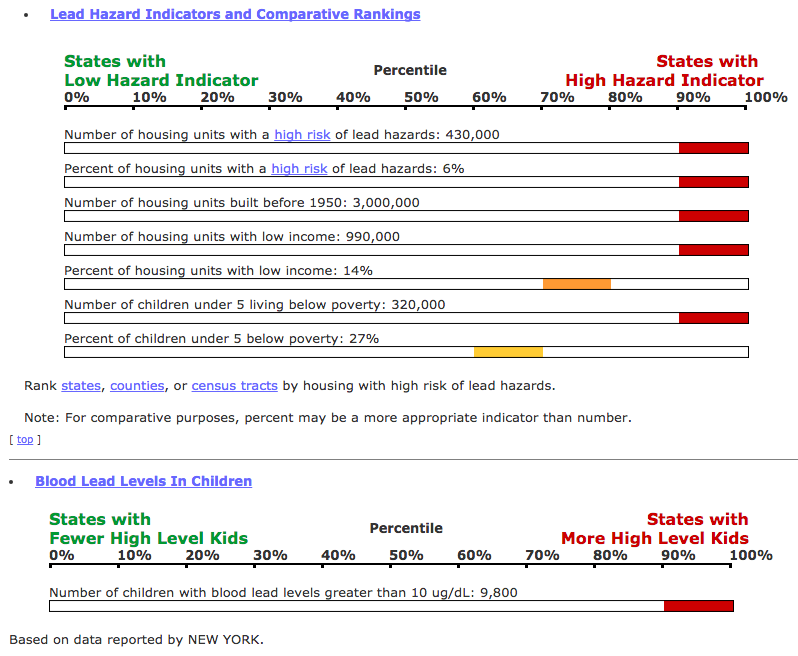
“The study’s results so far show that most Greenpoint backyard samples contain lead levels higher than the EPA’s recommended 400 ppm. Image: Franziska Landes“
NEUROTOXIC NEIGHBORHOODS
https://www.wnyc.org/story/combating-lead-poisoning/
https://www.reuters.com/supreme-court-allows-flint-water-contamination-lawsuits
https://www.usatoday.com/nearly-2000-water-systems-fail-lead-tests/
https://www.health.ny.gov/publications/2584/
http://www.brooklyn.cuny.edu/web/academics/centers/esac/services/soil.php
http://blogs.ei.columbia.edu/2017/10/09/many-backyards-in-brooklyn-neighborhood-are-contaminated-with-high-levels-of-lead/
“…some 92 percent of Greenpoint backyards have at least one sample that exceeds the lead level that the EPA designates as safe for residential soil. Some yards contain seven or eight times more lead than they should — higher than the levels found in some polluted Peruvian mining communities Landes has studied…”

“This chart shows the number of children per 1,000 expected to have blood lead levels exceeding five micrograms per deciliter, the level at which the CDC recommends taking action. Source: NYC Dept of Health, 2015”
HAIR MINERAL ANALYSIS TESTS
http://www.canaltlabs.com/hairmineralanalysis
http://www.canaltlabs.com/toxicmetals
http://www.canaltlabs.com/lead
“Lead is a potent neurotoxin that accumulates in soft tissues and bone over time. Lead poisoning was documented in ancient Rome, Greece, and China. Lead(II) acetate (also known as sugar of lead) was used by the Roman Empire as a sweetener for wine, and some consider this to be the cause of the dementia that affected many of the Roman Emperors…
Lead affects almost every organ and system in the body, targeting primarily the central nervous system but also the cardiovascular system, kidneys, and the immune system. Long-term exposure will cause significant impairment to the nervous system, severely damage the brain and kidneys and, in cases of exposure to high lead levels, ultimately cause death…”
LINKS to VIOLENCE
https://www.sciencedaily.com/releases/2012/04/120417162725.htm
https://www.huffingtonpost.com/ben-barber/lead-poisoning-linked-to-_b_3423272.html
https://myersdetox.com/category/toxic-metals/
https://myersdetox.com/lead-toxicity/
“Lead accumulates and makes its home in our bones, where the body prefers to store it. This is done in an effort by the body to protect vital organs. From there, it is released into the blood stream… Meaning, lead can continue to be released into the blood long after exposure… Lead begins leaching into their bodies from the breakdown of bone tissue. Symptoms like fatigue and brain fog begin to occur due to lead toxicity…
It has also been found that exposure to lead early in life may cause neurodegeneration in later life. Among the many neurocognitive effects of lead are: brain damage, mental retardation, memory loss, vision loss, behavior problems, antisocial behavior, and even violence…”

“Vehicles using leaded gasoline that contaminated cities’ air decades ago have increased aggravated assault in urban areas”
SYMPTOMS
http://medical-dictionary.thefreedictionary.com/saturnism
https://www.mayoclinic.org/diseases-conditions/lead-poisoning/symptoms-causes/syc-20354717
http://customers.hbci.com/~wenonah/hydro/pb.htm
http://www.nataliecox.com/Lead_pb_WATCH_for_Kids.html
-“Lead/pb causes mental regression in adults. Lack of motor control, partial to full paralysis, coma, and death can be attributed to lead/pb.
-Lead/pb is proven to cause cancer.
-Lead/pb can make your kidneys stop working.
-Lead/pb causes confusion, dizziness, forgetfulness, emotional disorder like self doubt, lack of self confidence.
-Lead/pb can make you lose your balance when you are trying to walk.
-Lead/pb causes blurred vision.
-Lead can make you see things that are not there.
-Lead/pb can cause stuttering, slurred speech, dyslexia. Lead/pb can make it difficult to talk out loud.
-Lead/pb makes your sense of smell go away.
-Lead/pb can make your teeth fall out earlier in life.
-Lead/pb can make you experience horrible anger.”

NATIONAL SCORECARD
http://scorecard.goodguide.com/community/index.tcl?zip_code=11222&set_community_zipcode_cookie_p=t&x=0&y=0
http://scorecard.goodguide.com/env-releases/lead/county.tcl?fips_county_code=36047
http://scorecard.goodguide.com/env-releases/def/lead_hazard_measures.html
http://scorecard.goodguide.com/env-releases/lead/
“NOTE: Potential hot spots of lead hazards in housing are identified based on indicators, not lead monitoring data. Because local data on lead contamination are generally unavailable, Scorecard relies on housing and demographic indicators to identify areas with housing that has a high risk of lead hazards. Scientific studies have demonstrated that housing built prior to 1950 and households with income below the poverty threshold have an elevated risk of lead contamination. Scorecard uses data from the 2000 U.S. Census for both of these risk factors to estimate potential lead hazards in housing.”
LEAD and EXCITOTOXICITY
https://link.springer.com/referenceworkentry/10.1007/978-1-4614-5836-4_142
https://academic.oup.com/brain/article/126/1/5/299373
Lead neurotoxicity in children / Brain, Volume 126, Issue 1, 1 January 2003
by Theodore I. Lidsky & Jay S. Schneider
“The direct neurotoxic actions of lead include apoptosis, excitotoxicity, influences on neurotransmitter storage and release processes, mitochondria, second messengers, cerebrovascular endothelial cells, and both astroglia and oligodendroglia. Although all of lead’s toxic effects cannot be tied together by a single unifying mechanism, lead’s ability to substitute for calcium [and perhaps zinc (Bressler and Goldstein, 1991)] is a factor common to many of its toxic actions. For example, lead’s ability to pass through the blood–brain barrier (BBB) is due in large part to its ability to substitute for calcium ions (Ca2+). Experiments with metabolic inhibitors suggest that back‐transport of lead via the Ca‐ATPase pump plays an important role in this process (Bradbury and Deane, 1993). More direct evidence for the role of the Ca‐ATPase pump in the transport of lead into the brain has been provided by in vitro studies of brain capillary endothelial cells, the primary constituent of the BBB (Kerper and Hinkle, 1997a, b)…
Apoptosis (programmed cell death) can be induced by a variety of stimuli. Apoptosis occurs when a cell activates an internally encoded suicide programme as a response to either intrinsic or extrinsic signals. One of the better characterized apoptotic cascade pathways has mitochondrial dysfunction as its initiator. Mitochondrial dysfunction initiated by the opening of the mitochondrial transition pore leads to mitochondrial depolarization, release of cytochrome C, activation of a variety of caspases and cleavage of downstream death effector proteins, and ultimately results in apoptotic cell death. While a variety of stimuli can trigger opening of the mitochondrial transition pore and cause apoptosis, a sustained intracellular increase in Ca2+ is one of the better‐known triggers; accumulation of lead is another. Lead disrupts calcium homeostasis, causing a marked accumulation of calcium in lead‐exposed cells (Bressler and Goldstein, 1991; Bressler et al., 1999). Lead, in nanomolar concentrations, also induces mitochondrial release of calcium (Silbergeld, 1992), thus initiating apoptosis…
Lead accumulates in and damages mitochondria (Anderson et al., 1996), the organelles mediating cellular energy metabolism. Haem biosynthesis, a function of normal mitochondrial activity, is affected by lead, with disruptive effects on synaptic transmission in the brain (see below, Indirect neurotoxic effects of lead). However, decreased mitochondrial functioning also can transform ordinarily benign synaptic transmission mediated by glutamate into neuron‐killing excitotoxicity (Beal et al., 1993)…”
EXPOSURE PATHWAYS
http://blogs.edf.org/health/2018/03/15/new-study-lead-low-levels-associated-risk-premature-death/
https://www.economist.com/news/international/21737253-paint-laced-lead-lingers-rich-countries-and-still-being-manufactured-poor
https://www.economist.com/news/leaders/21737272-use-lead-based-paint-spreading-poor-countries-and-does-terrible-damage-young
How to stop lead poisoning / Feb 22nd 2018
“Lead has proved to be such a useful, malleable metal that it turns up everywhere, from water pipes to window flashing and printing type. It went into car batteries and petrol additives. It also helped make bright pigments, used to paint walls, metalwork and toys. Yet lead is also a poison, and its ubiquity makes it a pernicious one (see article).
In the worst cases it causes comas, convulsions and death. More often it acts insidiously. It is a menace to toddlers, who are most likely to ingest contaminated dust and paint chips. Their brains are especially vulnerable. Only years after exposure are the results apparent in lower IQs, behavioural disorders and learning disabilities.
The dangers of lead have long been known. America banned it from paint 40 years ago, and by the late 1990s leaded petrol had been phased out in almost all rich countries. But the effects linger. Half a million American children are diagnosed with lead poisoning. The situation is more alarming in the poor world, where the use of lead-based paints is spreading. Curbing lead poisoning more than pays for itself. There is little excuse for poor countries to repeat the mistakes of rich ones.
The Romans did themselves no good by using lead for water pipes and sometimes even as a food sweetener. In 1786 Benjamin Franklin wrote a letter to a friend noting how the use of lead in distilleries had caused North Carolina to complain against New England Rum “that it poison’d their People, giving them the Dry Bellyach, with a Loss of the Use of their Limbs.”

“Members of the Michigan National Guard deliver water, filters, replacement cartridges and water test kits to Flint residents. Photo: Maj. Joe Cannon / U.S. National Guard via Flickr Creative Commons.”
In 2015 the Institute for Health Metrics and Evaluation, a research institute in Seattle, estimated that exposure to lead globally caused about 500,000 deaths that year and 12% of developmental disabilities, such as cerebral palsy and epilepsy. Another estimate is that lead poisoning costs Africa $135bn a year in lost output, the equivalent of 4% of GDP. The most urgent task is to stop putting more lead into the environment. As people in Asia and Africa become richer, they start to spruce up their homes. But the paint they use, even from pots labelled “lead-free”, often contains it. And they lack facilities to recycle lead batteries properly.

“National Guard members distribute water to citizens in Flint.”
It is neither difficult nor expensive to stop using lead. All countries should ban lead in paint. There should be no exemptions for industrial use, because the contamination spreads and industrial paint inevitably finds its way into the consumer market. Yet only four sub-Saharan African countries have formally enacted bans and local manufacturers are often unaware of the harm that lead causes.
The next step is to find and remove more of the lead introduced decades ago, particularly in rich countries. This will not be cheap, especially when the clean-up involves replacing lead pipes, as it often does in America. But the costs are worth it. The Pew Charitable Trusts, an NGO, reckons that every dollar spent on “lead abatement”—painting over old painted walls or removing flaking woodwork—saves at least $17 in medical and special-education costs, and lost productivity.

“Lee Anne Walters of Flint, Mich., pours gallons of bottled water into a bucket and pan to warm up for her twin sons to take a weekly bath. Her son, Gavin, 4, looking on, has been diagnosed with lead poisoning.”
In America investigations are typically carried out only in known cases of lead poisoning. However, children should not be used to test dangerous living conditions. It would be better to test older houses before problems appear. Cities and states need to make sure that landlords carry out remedial work. When poor owners cannot afford to fix their homes, the government should help as a prophylactic to save money on health care and education later. Charities that seek to help sick children and poor countries can contribute, too. There is no need to poison so many young minds.”
PREVIOUSLY
EXCITOTOXICITY
https://spectrevision.net/2018/01/18/excitotoxicity/
PRE-POLLUTED at BIRTH
https://spectrevision.net/2014/02/28/pre-polluted/
MEDICAL NUTRITION
https://spectrevision.net/2017/07/27/medical-nutrition/





